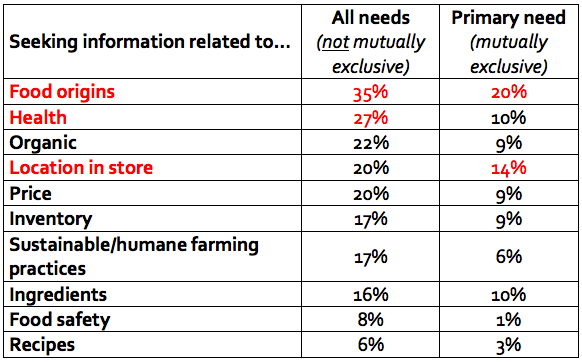This week, Shareable.net and Latitude Research have been exploring topics related to food–community-building around food, local, more sustainable systems for food production and distribution, ways to improve our experiences in food shopping environments, and technology solutions for making desired information more accessible to us at critical decision-making moments (such as while shopping for groceries).
Shareable and Latitude jointly conducted an idea generation study, using the power of collectivity creativity (“the wisdom of many”) to envision solutions for the future of food. Ultimately, each participant told us a story about a time they desired more information while food shopping, and then suggested a technology solution which might have solved this dilemma. Our three installments to date identified the main themes that emerged from the study–but not all responses fit tightly into those themes. In some cases, participants stretched them into new territory, truly thinking outside the box.
Below is a selection of “outliers” straight from participants mouths’ (or keyboards): potential solutions offered to address the various information gaps which people currently experience while making real-time decisions about food in store environments. They are non-representative good ideas that we thought were worth recognizing as ahead-of-the-curve–not to mention, potential food-for-thought for forward-thinking retailers.
Local community
“Food co-ops and many farmer’s markets already utilize the internet to give farmers more specific information about customer demand (less waste). The store of the next generation will look like a combination of the local farmer’s market and the food cooperative owned locally by the community. It will not only be a place to buy food, but a place to connect with your local community in real ways.” –Male, Age 36, (no city provided)
Physical navigation
“A simple map with all the items the store carries–as a touch screen on the carts and baskets and at the entrance would be great, or a PDA wifi in-store map or mobile Web site. And an online service of the same nature for pre-shopping planning.” –Male, Age 53, Gloucester, MA
Inventory and lists
“Have a digital display with the restock date–then tie it to a discount coupon (either hard copy or via SMS short code).” –Female, Age 40, San Francisco, CA
“Install RFID/barcode scanners, weight sensors in cupboards and the fridge; wire them all up to a Web server running some sort of inventory software that can serve XML feeds of my current home inventory to my phone.” –Male, Age 33, Milford, CT
Comparison and personalized convenience
“Give me an augmented reality device which I can hold up in front of an item on a shelf and it will overlay apples-to-apples comparisons of that item against those offered at my default stores as well as any in the area offering same item. And, ideally, it would use natural language. ‘No, don’t get that here. It’s cheaper at XYZ and you’re going there next anyways to also buy ABC and DEF.'” –Male, Age 46, Cleveland, OH
Recommendation services
“An ingredient ‘anagrammer’–an app that would tell me various recipes I could make using the ingredients I currently own (with the addition of a few store purchases). It could dynamically suggest recipes and ingredients I might like based on my current ingredients, past ratings and personal preferences.” –Female, Age 25, Cambridge, MA









